颅脑血管超声操作流程
血管超声操作及测量手法

h
7
血流方向
y
声束入 射方向
x
h
8
h
9ห้องสมุดไป่ตู้
周围血管的走行常与皮肤接近平行,减小声束与血流 方向的夹角的方法:
(1)线阵探头角度独立偏转(彩色框倾斜) (2)探头不平衡加压(探头两段施加的压力不等) (3)利用介质制造倾斜:水囊、耦合剂
h
10
h
11
3、提高彩色增益(color gain)
彩色增益过低,则表现为管腔内彩色血流信号充盈 不佳且着色暗淡
椎动脉:起自锁骨下动脉,向上穿第6-1颈椎横突 孔,经枕骨大孔入颅。
h
42
髂外动脉:经腹股沟韧带中点深面至股前部,移行 为股动脉;出收肌腱裂孔至腘窝,移行为腘动脉; 向下移行为胫前及胫后动脉;胫前动脉移行为足背 动脉。
h
43
h
44
h
45
h
46
h
47
h
48
h
49
h
50
h
51
感谢下 载
彩色增益过高,引起彩色外溢
h
12
h
13
4、建立较佳的壁滤波
消除血管搏动、瓣膜活动等引起的彩色伪像。 壁滤波过小不足以消除伪像,过大则抑制血流的多
普勒信息
h
14
5、建立较佳的彩色速度刻度 (color velocity scale)或脉冲 重复频率(pulse repetition frequency)
节彩色速度标尺,壁滤波、彩色增益等获取最佳的 彩色血流图 3、在最佳的彩色血流图上取多普勒频谱。彩色血 流图有助于选择性地取多普勒和帮助多普勒取样容 积。
h
5
探头频率的选择
经颅多普勒超声操作规范及诊断标准指南

·专家论坛·经颅多普勒超声操作规范及诊断标准指南华扬高山吴钢潘旭东钱素云一、概述经颅多普勒超声(,)是利用人类颅骨自然薄弱的部位作为检测声窗(如颖骨磷部、枕骨大孔、眼眶),对颅底动脉血流动力学进行评价的一种无创性检查方法。
适应证:脑动脉狭窄和闭塞、颈动脉狭窄和闭塞、脑血管痉挛、脑血管畸形、颅内压增高、脑死亡、脑血流微栓子监测。
操作方法和程序:探头频率选择:颅内动脉探测采用的脉冲波多普勒探头,颅外段颈动脉探测采用连续波多普勒探头。
若选择或的脉冲波多普勒探头检查颅外段颈动脉时,应降低探头发射功率和检测深度,通常功率为,最初检测深度为。
检测部位:()颖窗:分前、中、后三个声窗,通常后窗是检测大脑半球动脉的最佳选择,易于声波穿透颅骨及多普勒探头检测角度的调整,通过颖窗分别检测大脑中动脉(,)、前动脉(即交通前段段,,)、后动脉(,)和颈内动脉末段(,),并可通过压迫颈总动脉判断前交通动脉(,)和后交通动脉(,)的发育情况;()眼窗:探头置于闭合的眼睑上,声波发射功率降至;通过眼窗可以检测眼动脉(,)、颈内动脉虹吸部(,),在颖窗信号不好时可检测对侧和;颈内动脉虹吸部包括海绵窦段(段)、膝段(段)和床突上段();()枕窗:探头置于枕骨粗隆下方,发际上左右,枕骨大孔中央或旁枕骨大孔,通过枕窗检测双侧椎动脉(,)、小脑后下动脉(,)和基底动脉(,)。
检测动脉:()颅外段颈动脉:探头置于锁骨上窝,首先获得颈总动脉(,)血流信号,然后将探头沿颈总动脉长轴,声束与血管夹角小于,探头移动至下颌角水平(连续波多普勒探头)或探头位置不变,探测深度由增加至(脉冲波多普勒探头),声束朝向前内侧,获得高阻力型的颈外动脉(,)血流信号。
将声束朝向后外侧,获得低阻力型颈内动脉()血流信号。
另外,可通过颖浅动脉震颤试验作者单位:北京,首都医科大学宣武医院血管超声科(华扬);北京协和医院神经内科(高山);福建医科大学一附院神经内科(吴钢);青岛医学院一附院神经内科(潘旭东);北京市儿童医院重症监护科(钱素云)对颈内外动脉加以鉴别;()颅内动脉:通过颖窗、枕窗和眼窗分别检测双侧大脑半球动脉、椎基底动脉及眼动脉和颈内动脉虹吸部各段血流信号。
经颅二维超声检查引导的经颅多普勒监测
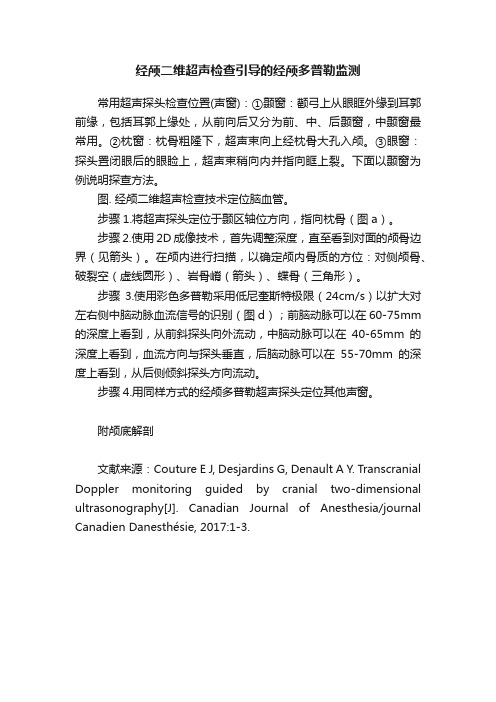
经颅二维超声检查引导的经颅多普勒监测
常用超声探头检查位置(声窗):①颞窗:颧弓上从眼眶外缘到耳郭前缘,包括耳郭上缘处,从前向后又分为前、中、后颞窗,中颞窗最常用。
②枕窗:枕骨粗隆下,超声束向上经枕骨大孔入颅。
③眼窗:探头置闭眼后的眼睑上,超声束稍向内并指向眶上裂。
下面以颞窗为例说明探查方法。
图. 经颅二维超声检查技术定位脑血管。
步骤1.将超声探头定位于颞区轴位方向,指向枕骨(图a)。
步骤2.使用2D成像技术,首先调整深度,直至看到对面的颅骨边界(见箭头)。
在颅内进行扫描,以确定颅内骨质的方位:对侧颅骨、破裂空(虚线圆形)、岩骨嵴(箭头)、蝶骨(三角形)。
步骤3.使用彩色多普勒采用低尼奎斯特极限(24cm/s)以扩大对左右侧中脑动脉血流信号的识别(图d);前脑动脉可以在60-75mm 的深度上看到,从前斜探头向外流动,中脑动脉可以在40-65mm的深度上看到,血流方向与探头垂直,后脑动脉可以在55-70mm的深度上看到,从后侧倾斜探头方向流动。
步骤4.用同样方式的经颅多普勒超声探头定位其他声窗。
附颅底解剖
文献来源:Couture E J, Desjardins G, Denault A Y. Transcranial Doppler monitoring guided by cranial two-dimensional ultrasonography[J]. Canadian Journal of Anesthesia/journal Canadien Danesthésie, 2017:1-3.。
新生儿颅脑超声检查规范

超声科 朱朝霞
筛查对象及检查时间
• 所有高危儿均应在出生后7天内接受1次扫查,14天 后再做一次。所有孕周小于34周的新生儿均应常规 接受颅脑超声检查。
(-)检查要求:
• 1、检查时,陪同医务人员需提供安抚奶嘴,对新 生儿进行安抚以便配合检查
• 2、危重婴儿宜在新生儿病房进行,请儿科医师陪 同
第三脑室层面
➢侧脑室中央-后角层面
• 经前囟正中矢状面检查
• 正中矢状切面
经前囟左右旁矢状面检查
• 左右旁矢状面侧脑室中央前角切面 • 左右旁矢状面侧脑室中央后角切面
经
经
前
乳
囟
突
囟
• 报告给图要求
• 三幅图 • 经前囟冠状面第三脑室切面,左右旁矢状面侧脑 室切面及血流图
•注(有阳性病例的必给阳性图)
(三)检查方法
• 1、探头选择
• 先使用经颅探头(如无,可用小儿心脏探头代替), 频率范围5-7.5MHz。 • 后使用高频探头,显示近场颅脑边缘及脑外间隙结 构。
• 2、检查方法
• 经前囟冠状面检查 • 经前囟正中矢状面检查 • 经前囟左右旁矢状面检查• 3、检查基本参数测定
• 双侧侧脑室外侧壁距中线距离。 • 左右侧脑室体部宽度。 • 后角宽度。 • 第三脑室宽度。 • 透明隔宽度。 • 大脑半径。
• 3、应注意保暖和预防交叉感染,探头和导线用酒 精擦拭消毒。
• 4、手法应轻柔,不可重压前囟,以免颅内压升高 而加重病情。
(二)检查流程:
• 1、核对新生儿的姓名,性别,出生天数 → 按 照检查内容进行检查 → 规范存图 → 复核存 图 → 结束检查 →出具报告 • 2、检查发现有异常者: • ① 有两名医生检查并签名 • ② 在提示中写:建议做进一步检查 • ③ 填写特殊病例登记本,登记须完善 • ④ 首诊医生、专人进行追踪登记
经颅多普勒操作规程
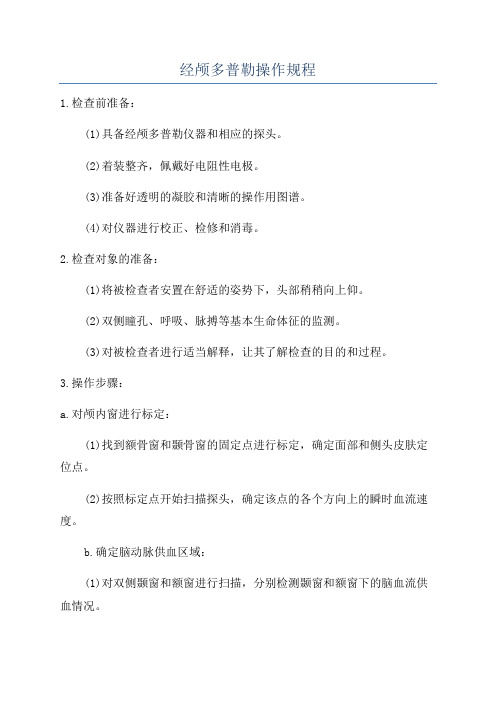
经颅多普勒操作规程1.检查前准备:(1)具备经颅多普勒仪器和相应的探头。
(2)着装整齐,佩戴好电阻性电极。
(3)准备好透明的凝胶和清晰的操作用图谱。
(4)对仪器进行校正、检修和消毒。
2.检查对象的准备:(1)将被检查者安置在舒适的姿势下,头部稍稍向上仰。
(2)双侧瞳孔、呼吸、脉搏等基本生命体征的监测。
(3)对被检查者进行适当解释,让其了解检查的目的和过程。
3.操作步骤:a.对颅内窗进行标定:(1)找到额骨窗和颞骨窗的固定点进行标定,确定面部和侧头皮肤定位点。
(2)按照标定点开始扫描探头,确定该点的各个方向上的瞬时血流速度。
b.确定脑动脉供血区域:(1)对双侧颞窗和额窗进行扫描,分别检测颞窗和额窗下的脑血流供血情况。
(2)通过检测双侧大脑中动脉、大脑前动脉、大脑后动脉、基底动脉、椎动脉等主要脑动脉的血流速度和形态,确定血管供血区域。
c.检测血流方向和流速:(1)在确定的脑动脉供血区域内进行脑血流测量。
(2)按照探头发射超声波的位置和角度,调整探头位置,使其与待测动脉平行。
(3)通过观察血流的方向和形态来判断脑血管供血状况,如是否存在闭塞、狭窄、扩张等情况。
(4)通过跟踪一个特定血管的声音,记录最大收缩期峰值血流速度、舒张期峰值血流速度,并确定其平均速度。
d.检测血流的峰值速度和形态:(1)检查辅助窗口的脑血流情况。
(2)对比正常值,评估血流速度、形态是否存在异常。
e.记录和分析结果:(1)将检查结果和分析记录在病历上,并进行相应的分析和解释。
(2)对检查结果进行初步判断,作为疾病诊断和治疗的依据。
总结:经颅多普勒操作规程主要包括检查前准备、检查对象的准备、操作步骤以及记录和分析结果。
通过标定颅内窗、确定脑动脉供血区域、检测血流方向和流速以及检测血流的峰值速度和形态,可以对脑血流进行定量评价和诊断脑血管疾病。
这一操作规程有助于保证检查的准确性和可靠性,为疾病的早期发现和诊断提供了重要的依据。
TCD仪器操作流程
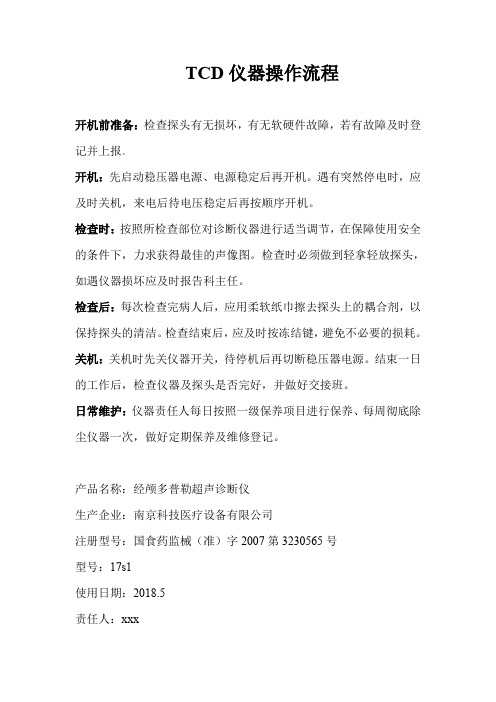
TCD仪器操作流程
开机前准备:检查探头有无损坏,有无软硬件故障,若有故障及时登记并上报。
开机:先启动稳压器电源、电源稳定后再开机。
遇有突然停电时,应及时关机,来电后待电压稳定后再按顺序开机。
检查时:按照所检查部位对诊断仪器进行适当调节,在保障使用安全的条件下,力求获得最佳的声像图。
检查时必须做到轻拿轻放探头,如遇仪器损坏应及时报告科主任。
检查后:每次检查完病人后,应用柔软纸巾擦去探头上的耦合剂,以保持探头的清洁。
检查结束后,应及时按冻结键,避免不必要的损耗。
关机:关机时先关仪器开关,待停机后再切断稳压器电源。
结束一日的工作后,检查仪器及探头是否完好,并做好交接班。
日常维护:仪器责任人每日按照一级保养项目进行保养、每周彻底除尘仪器一次,做好定期保养及维修登记。
产品名称:经颅多普勒超声诊断仪
生产企业:南京科技医疗设备有限公司
注册型号:国食药监械(准)字2007第3230565号
型号:17s1
使用日期:2018.5
责任人:xxx。
【医学课件】颅脑超声

颅脑手术后的随访中,颅脑超声 可用于观察术后的恢复情况,判 断手术效果及有无并发症的发生 。
颅脑超声可用于筛查颅内动脉瘤 、脑血管狭窄等血管性疾病,通 过观察血管的形态和血流情况, 为进一步的诊断和治疗提供依据 。
颅脑超声的优势与局限性
优势
颅脑超声具有无创、无辐射、操作简便、价格低廉等优点, 适用于各个年龄段的人群,可用于筛查和诊断各种颅脑疾病 。同时,颅脑超声还可以提供脑组织的血流情况和血管情况 ,有助于判断疾病的严重程度和预后。
详细描述
颅脑损伤的超声诊断主要依靠急诊床旁超声 ,可快速诊断损伤部位及程度,判断脑组织 水肿、出血等情况,同时可观察脑室大小、
形态变化等,为临床抢救提供参考。
感谢您的观看
THANKS
颅脑超声
2023-11-06
目录
• 颅脑超声概述 • 颅脑超声检查技术 • 颅脑疾病超声诊断 • 颅脑超声与其他影像学检查的比较 • 颅脑超声在临床上的应用价值 • 颅脑超声病例分析
01
颅脑超声概述
定义与原理
• 颅脑超声是一种利用高频超声波对颅脑进行扫描和成像的技 术。它通过将高频超声波束照射到头部,接收回声信号并转 换为图像,从而显示脑组织的结构和功能。颅脑超声具有无 创、无辐射、操作简便、价格低廉等优点,被广泛应用于临 床诊断和治疗中。
局限性
颅脑超声受限于操作者的技术水平和仪器设备的精度,对于 某些深部病变的显示可能不够清晰。此外,颅脑超声对于骨 质的穿透能力较差,对于颅骨内病变的显示有一定限制。
02
颅脑超声检查技术
检查前准备
确认患者身份
确保患者信息与检查申请单相符,包括姓 名、性别、年龄、住院号等。
告知检查流程
向患者解释颅脑超声检查的流程、注意事 项及可能存在的风险。
经颅多普勒(TCD)操作规程
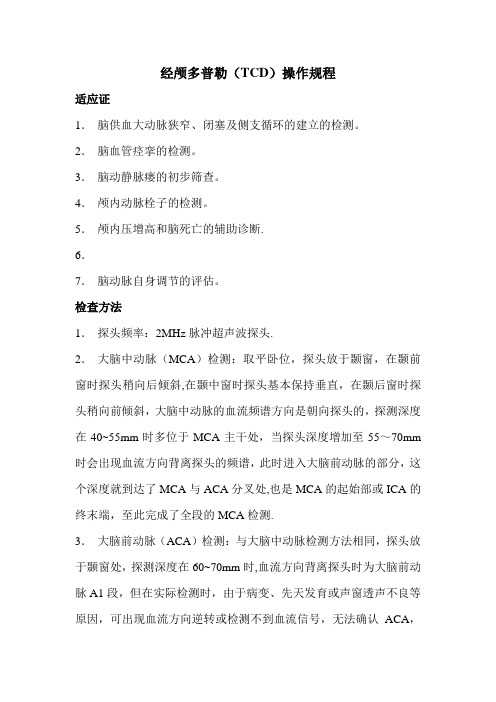
经颅多普勒(TCD)操作规程适应证1.脑供血大动脉狭窄、闭塞及侧支循环的建立的检测。
2.脑血管痉挛的检测。
3.脑动静脉瘘的初步筛查。
4.颅内动脉栓子的检测。
5.颅内压增高和脑死亡的辅助诊断.6.7.脑动脉自身调节的评估。
检查方法1.探头频率:2MHz脉冲超声波探头.2.大脑中动脉(MCA)检测:取平卧位,探头放于颞窗,在颞前窗时探头稍向后倾斜,在颞中窗时探头基本保持垂直,在颞后窗时探头稍向前倾斜,大脑中动脉的血流频谱方向是朝向探头的,探测深度在40~55mm时多位于MCA主干处,当探头深度增加至55~70mm 时会出现血流方向背离探头的频谱,此时进入大脑前动脉的部分,这个深度就到达了MCA与ACA分叉处,也是MCA的起始部或ICA的终末端,至此完成了全段的MCA检测.3.大脑前动脉(ACA)检测:与大脑中动脉检测方法相同,探头放于颞窗处,探测深度在60~70mm时,血流方向背离探头时为大脑前动脉A1段,但在实际检测时,由于病变、先天发育或声窗透声不良等原因,可出现血流方向逆转或检测不到血流信号,无法确认ACA,此时需要结合压颈试验进行判断.4.大脑后动脉(PCA)检测:与大脑中动脉检测方法相同,探头放于颞窗处向后侧微倾,在55~75mm处可以探测双向血流频谱,其中朝向探头的为PCA的P1段,背向探头的为P2段。
通常情况下PCA 流速要慢于MCA、ACA,通常PCA是由BA供血,但也可由ICA 供血,可由压颈试验进行鉴别。
如果压颈后PCA流速增高则表明PCA 由BA供血,且后交通动脉存在;如果压颈后PCA流速不变则表明PCA 由BA供血,且后交通动脉发育不良;如果压颈后PCA流速减慢则表明PCA发生变异,由ICA供血.5.颈内动脉终末端(TICA)检测:在大脑中动脉检测时,当探测深度加深至60~70mm时,会出现双向血流频,此时把探头稍向下倾斜,可以探查到朝向探头的血流频谱,此为TICA。
实际中,MCA和TICA 血流同向,需进行压颈试验鉴别,当压迫CCA时,TICA会出现血流消失或反向小尖波,而MCA表现为血流速度下降.6.椎动脉(V A)和基底动脉(BA)检测:可取坐位,头部向前倾并尽可能使下颌接触到胸部,探头放于枕窗,探测深度为60~70mm 处,出现背向探头的血流频谱为椎动脉(V A),随着深度增至70~80mm,同时探头方向稍向内侧转动,出现背向探头的血流频谱为基底动脉(BA)。
血管内超声(IVUS)操作规范

血管内超声(IVUS)操作规范[原理]血管内超声(intravenous ultrasound,IVUS)是指无创性的超声技术和有创性的导管技术相结合,使用末端连接有超声探针的特殊导管进行的医学成像技术。
通过心导管将微型化的超声换能器置入心血管腔内,多晶片换能器环形阵列或单晶片换能器高速旋转(1800转/分)完成360°动态血管截面扫描,通过成像处理系统,回波信号强弱以灰阶形式显示,二维横截面成像,显示心血管断面形态。
[适应症]血管内超声主要应用于冠状动脉系统的诊断、指导、评估。
1.冠状动脉造影不能明确诊断的病例,如:临界病变、模糊病变;2.指导一些复杂、特殊病变,如:左主干病变、开口及分叉病变、 CTO病变、桥血管病变等;3.需明确病变形态和斑块性质;4.评价病变长度,明确支架的选择和放置;5.评价支架植入术等冠状动脉介入治疗疗效;6.冠状动脉病变的远期随访性研究。
[禁忌症]无绝对禁忌症。
[用物准备]1.IVUS主机、IVUS连接盒(PIM盒)、自动自动回撤装置;2.IVUS导管;[操作流程]1.如需VH-IVUS和FFR功能,开机前先连接主机后下方的ECG和BP电缆线,导入心电信号和有创压;2.启动主机,新建病例,视屏右上角红心闪烁证明心电信号连接成功,无心电信号将丢失VH-IVUS功能,但不会影响灰阶IVUS的录制;3.进入HOME界面(实时录制状态);4.将PIM盒(IVUS导管连接盒)放入无菌袋,IVUS导管连接PIM盒,待视屏左下方提示catheter Insert再将导管送入体内;5.在血管造影检查的基础上,选定所需检查的血管和病变部位;6.同普通介入治疗,按1000IU/Kg追加普通肝素,防止导管血栓;7.采用6 F及以上的指引导管放置到冠状动脉口,将0.014英寸的指引导丝送至靶血管的远端;8.将血管内超声导管(电子相阵控)沿指引导丝送至指引导管口(冠脉开口)暂停,按下RING DOWN键待环晕伪影消失再继续推送;9.将超声导管送至需要进行检查的病变部位的远端,按下RECORD键,自靶血管的远端至冠脉开口以一定的速度连续回撤,完成完整超声影像录制,然后对感兴趣的部位再重点检查的;10.录制过程VH Off,只要接通心电信号就具有VH-IVUS信息;彩色血流功能需要事先选择,按Chroma键,视屏下方显示Chroma Flow on;11.最后对采集的影像进行测量、分析、整理、存档。
经颅多普勒超声的操作规程第1部分:检测步骤

经颅多普勒超声的操作规程第1部分:检测步骤2007年9月第15卷第9期—lntJCe—rebrovascDis,September2007,V ol15,No.9经颅多普勒超声的操作规程第1部分:检测步骤PracticeStandardsfor【韧c聊iDopplerUltrasourdPartI:TestPerformanceAndreiV.Alexandrov,Michael久Sloan,LawrenceK.S.Wong,ColleenDouville,AlexanderY.Razumo~ky,WalterJ.Koroshetz,ManfredKaps,CharlesH.Tegeler代表美国神经影像学学会实践指南委员会着倪秀石,凌茹晶译-641?标准与指南?摘要尽管经颅多普勒(TCD)临床应用的适应证不断被拓宽,但各机构之间的扫描方案和报告质量却存在很大差异.根据文献分析和广泛的个人经验,一个国际专家小组开始制定qL-~D检测步骤,判读标准和操作者资质的指南.第一部分介绍针对脑血管病患者的完整的诊断性频谱TCD检测.颞窗被用于检测大脑中动脉(MCA),大脑前动脉(ACA),大脑后动脉(PCA),颈内动脉(ICA)CI段以及通过前交通动脉(ACoA)和后交通动脉(PCoA)的侧支血流;眼窗被用于检测眼动脉(OA)和ICA虹吸部;枕窗被用于检测椎动脉(V A)终末段和基底动脉(BA).尽管在疾病或非疾病情况下Willis环都存在显着的个体差异,但完整的诊断性qUD检查应该包括对以下血管的评估:双侧MCAM2段(深度30~40mil1)和M1段(40~65mil1)(MCAM1段中点深度为50mill,范围44~55mm;平均长度16mill.范围5~24mil1),ACAA1段(60~75toni),ICAC1段(60~70toni),PCAP1~P2段(平均深度63I/1//1,范围55~75I/1//1),ACoA(70~80I/1//1),PCoA(58~65m//1),OA(40~50m//1),ICA虹吸部(55~65mil1),V A终末段(40~75mil1)以及BA近端(75~80mil1),中段(80~90mil1)和远端(90~110mil1).经下颌下窗检测颈部ICA远端(40~60mln)可计算出VMCA/VICA指数或Lindegaard比率,对蛛网膜下腔出血后的血管痉挛进行分级.诊断性"ICD的操作目标是探测和优化上述动脉节段特异性频谱波形,确定血流方向,测定脑血流速度和血流搏动性.这些操作规程为频谱多普勒和能量运动多普勒的超声检测装置提供了有关探头位置和血流方向,取样深度和血管鉴别的一套标准的扫描方案,帮助超声实验室取得资格认证.关键词经颅多普勒;脑血管病;实践指南1引言自从经颅多普勒(transcranialDoppler,TCD)问世以来,其临床应用的适应证不断被拓宽].FromtheBarrowNeⅦ_olo百calInstitute,Phoenix.AZ(All0a'eiV.Alex-ar-ov】;CarolinasMedicalCemer,Charlotte,NC(MichaelASloan);Chi—neseUni~ersityofHongKong,HongKong,China(LawrenceK.S.Wong); SwedishHospital,Seattle,WA(ColleenDouville);SentiemMedica/Sys—terns,Inc.,Cockeysville,MD(AlexanderY.R21zarnovsky):HarvardMedicalScl】ool,Boston,MA(WalterJ.Koroshetz1:Uni~ersityofGiessen,CJiessen, Germany(ManfredKaps);andWakeForestUni~ersitvMedicalCenter.Win- ston-Salem,NC(CharlesHTegeler)译者单位:200080上海市第一人民医院神经内科原文见:JNeuroimaging.2007.17:l1—18.各机构之间在TCD扫描方案,检测血管数量,常规检测的深度范围以及TCD检查的报告方面存在很大差异.鉴于血管检查实验室资格认证的重要性,需要对扫描和判读过程进行标准化.我们倡议TCD方面的专家以及美国神经影像学学会实践指南委员会(AmericanSocietyofNeuroimaging PracticeGuidelinesCommittee)和国际神经超声学组织的成员一起制定一系列的标准和指南.第一部分是该专家小组对脑血管病患者完整的诊断性TCD检测推荐的操作规程.2完整的诊断性TCD检测技术642?!生!旦筮鲞筮期肋JCerebrovc~cDisRuneAaslid引入单通道频谱TCDl1使用下列声窗对脑血流动力学进行无创性评价(图1A,B):颞窗,眼窗,枕窗和下颌下窗j.完整的TCD检测不仅包括双侧脑血管系统的评价,而且还包括利用这4个声窗检测前循环和后循环血流.颞窗被用于检测大脑中动脉(middlecerebralartery,McA),大脑前动脉(anteriorcerebralartery,ACA),大脑后动脉(posteriorcerebralartery,PCA),颈内动脉终末段(terminalinternalcarotidarteries.TICA)或ICAC1段¨.眼窗被用于检测眼动脉(ophthalmicartery,OA)和ICA虹吸部;枕窗被用于通过枕骨大孔检测椎动脉(vertebralartery,VA)末端和基底动脉(basilarartery,BA).脑血流动力学应被看作是一个紧密相互依赖的系统.尽管下面的章节提供了深度范围,但应注意到血管节段的解剖形态, 血流速度和搏动性可能因解剖变异或Willis环和其他血管部位的病变而发生变化.对于存在脑缺血症状或有卒中风险的患者,神经重症监护室内的各种其他疾病患者以及慢性疾病(如痴呆)患者,完整的诊断性TCD检测应该包括对双侧MCAM2段(深度30~40mm),M1段(40~65lnm),ACAA1段(60~75mrn),ICAC1段(60~.,隐宙靳密曩瀚._豳忧t●^J口郁3.前部D右左F鼻蕤.1so60国.,…,1t/.)fl…/,:,jf'6005dXJ('/\Ⅷ_='…….7.,麓篓+\中线(1~4)/虹吸部上肢lG6~O.—一.~一球2j下颌骨/一一下颌下窗探头U图1TCD检测的声窗,完整评价的关键动脉节段以及中等体型成年人的检测深度范围血管旁的实心箭头示iE常的动脉血流方向;从超声探头处(F)发出的实心箭头示探头在枕窗的移动和定佗(B);空心箭头示取样容积随着超声深度的变化而改变2007年9月第l5卷第!70mm),PCAP1~P2段(55~75mm),前交通动脉(anteriorcommunicatingartery,ACoA)(70~80ITI1TI),后交通动脉(posteriorcommunicatingartery,PCoA)(58~65mm),OA(40~50mm),ICA虹吸部(55~65mm),V A终末段(40~75ITI1TI)以及BA近端(75~80ITI1TI),中段(80~90ITI1TI)和远端(90~105ITI1TI)的评价.虽然没有考虑强制性将TCD检查扩展到分支动脉,~HMCAM2段,但这些指南强调无论何时收到诊断性TCD的医嘱,都必须进行完整的检测,除非特别限定检测范围.需要注意的是,超声深度随颅骨大小和个体解剖学差异而有所不同,上述血管节段可能重叠或位置更深,也就是说,BA近端可在85rnin处被发现,等等.下颌下窗被用于蛛网膜下腔出血患者,检测接近颅骨人口处的ICA远端(40~60mm)血流速度以计算VMCA/VICA指数,即Lindegaard比率¨』.这种比率容易变化,因为ICA血流速度轻微降低可能会明显高估血管痉挛程度.为了缩短频谱TCD寻找声窗和识别不同动脉节段所需要的时间,对颞窗和枕窗的检测可从最大功率和较大的通道设置开始(即对给定的深度使用100%功率但不超过720mW,通道或取样容积为10~15ITI1TI).虽然这项推荐表面上违反了超声功率的合理使用低剂量原则(aslowasreasonably achievable,At_ARA),但能缩短寻找颅骨声窗的时间和更迅速地完成检测,尤其是对于老年患者,从而减少患者总体超声能量暴露.超声检查操作者可能更喜欢从运动模式(M型)多深度显示或较小的5~10mm频谱通道开始检测,以降低血管识别的不确定性;如果没有找到声窗,则增大通道.如果在全功率时很容易找到颞窗并且获得高回波频谱,则应减小通道和降低超声功率以使患者暴露的超声能量降至最低.经眼窗或囟门进行TCD检测时,应使用较低的功率(10%).对于典型的诊断性TCD检测,使用快速的3~5s扫描速度可看到波形和频谱的细节以提高判读能力(图1C).基线放置在屏幕中间能够显示双向信号.如果血流速度很快,就需降低基线和增大标尺以避免混叠现象.调节增益使背景噪声最小但维持存在.如果颞骨厚度造成信号过度衰减而使声窗受限,则最好延长扫描时间,以便为超声操作者提供更多时间来选择探头位置,调整图像和优化多普勒频谱.如果遇到微弱的高流速信号,操作者可在极643?慢的扫描速度下调高增益以显示波形中的最高多普勒频率.调节增益可优化波形以避免混叠现象,并且使背景噪声保持在最低限度.使用包络线或波形跟踪器仔细检查自动读数的准确性,如检测到的信号微弱或怀疑包络线描记有误,则采用手动光标测量.在频谱TCD检测过程中,操作者应该I89J:(1)跟踪Willis环每条重要分支的血流走行.(2)对于每条动脉,至少识别,优化和储存2个关键点的频谱波形(图1D,F,G);对于MCA,储存近端,中段和远端信号;对于VA,储存40~50ITI1TI和60~70ITI1TI处信号;对于BA,储存近端,中段和远端信号,并且给出这些节段的长度和流速变异性.(3)识别,优化和储存任何异常或罕见的波形或信号.(4)在每个关键点测定最高流速信号.注意:可通过颈总动脉(commoncarotidartery,CCA)和椎动脉振动或压迫试验来识别颅内血管. CCA压迫试验在美国并不常规使用,只有在直接血管成像排除CCA粥样斑块后才能采用,因有造成卒中的轻微风险.以下检测步骤和血管识别规程源自一些有关TCD的原创性研究报告和验证研究[1,2,8,10-14].深度范围和血流方向也适用于能量运动多普勒(power motionDoppler,PMD)n或经颅双功能技术引导的频谱检测.2.1经颞窗的检测步骤(图1A,B,D)2.1.1步骤1设定深度为50ITI1TI(已知MCAM1段中点深度在约50ITI1TI处13j).将探头放置在颧弓上方并略向上向前对准对侧耳/颞窗.注意:采用后颞窗时,检查开始时的探头角度可能要更向前以避开PCAP1段.寻找任何血流信号(窗口),探头角度要避免垂直,向下或过于偏后.找到一个朝向探头的血流信号,这很可能就是MCA血流.正常的MCA血流为低阻力波形(图1c),与ICA血流波形相似.减小取样深度,追踪信号至M1远端的关键点,保持信号不致丢失,通常需要微调探头角度.MCA 远端位于更上和更前方,而MCA近端则在探头与颞骨呈90.直角时更易探测到.储存MCA远端(深度为30~40ITI1TI)的最高流644?!年—第l5卷第9期胁JCerebrovascDis速信号.如发现双向信号,储存每个方向的最高流速信号(M1远端一M2近端分支).2.1.2步骤2跟踪信号,直至取样深度减至30mlTl时信号消失为止.预期MCAM2段的流速低于MCAM1段.储存所有异常信号,包括(但不仅限于)高流速,高阻力波形,湍流信号,极低阻力以及延迟性收缩期血流加速度.返回至MCAM1远端信号.2.1.3步骤3跟踪MCAM1段主干直至其中部(45~55mlT1)和位于60~65ITI1TI深度的M1段起始部,超声深度取决于成年人颅骨的厚度.由于TICA的超声信号也可能位于这些深度,因此需要注意声音和流速的改变.切记MCAM1段是ICAC1段的延续.储存MCA近端最高流速信号.MCA近端信号通常通向ICA分叉部.根据超声通道(取样容积)的大小,可在5l~65mlTl深度范围检测到ICA分叉部.在60~65mlTl处储存ICA分叉部信号以获得MCAM1段近端及ACAA1段近端信号.如果使用大通道超声,则储存分叉部的双向信号(M1/A1),这可作为鉴别其他血管的标记.2.1.4步骤4跟踪ACAA1段远端全程信号,通常到达70~75mlTl深度(ACAA1的平均长度为l3.5mlTl,范围为8~l8.5mlT1),可能终止于ACAA2段水平部,非成像多普勒技术无法可靠地将其与AJ段鉴别.在70mlTl深度处储存ACAA1段远端信号.2.1.5步骤5跟踪ACAA1段远端信号至中线深度范围(75~80mlT1).在中线深度处,ACAA1段信号可能会消失或出现一个双向信号,此时朝向探头的血流为对侧ACA.尽管在中线深度对双侧ACA的超声探测可能显示通过ACoA的前交叉充盈(anterior—crossfilling)血流模式,但实际上不可能将ACoA血流与相邻的ACA区分开来,因为超声通道总是大于ACoA本身,并且同时覆盖双侧ACAA1段和ACoA.最后,可见多条ACoA连接ACAA1段和A2段.储存所有异常信号.返回到60~65IYUTI深度处的ICA分叉部.2.1.6步骤6从ICA分叉部,探头角度向下找到60~65mlTl处的][1CA信号.如果在60~70mlTl深度处探头对ICA分叉部的角度是向下和向前的,可通过颞窗探测到ICA床突上虹吸段的远端部分.注意:TICA信号可能由于受声角度不佳而呈圆钝信号.储存所有异常信号.返回到60~65mrn深度处的ICA分叉部.2.1.7步骤7将深度设定在62mrn并缓慢将探头后转10~30..通常在ICA分叉部与PCA信号之问存在一个血流间隙(flowgap).在55~75mlTl深度范围内找到朝向(Pl段/P2段近端)和背离(P2更远端)探头的PCA信号.记住:PCAP1段起始于BA顶端,如果探头放置在颞窗后部,可在比PCAP2段更深的部位探测到PCAP1段.通过这些深度和探头的转动可探测到通过PCoA的侧支血流.储存PCAP1段或P2段最高流速信号.2.2经眼窗的检测步骤(图lE)2.2.1步骤l将功率降至最小(17mW)或10%.深度设定在50mlTl,将探头放置在眼睑上并稍向内成角.确定OA远端血流的搏动和方向.储存最佳的OA远端信号(40—50mlTl深度范围).2.2.2步骤2增加深度到55~65mlTl,探i贝0到ICA虹吸部血流信号.虹吸部信号通常位于眼窗内侧.储存60~62mlTl处(c3段或虹吸部膝段)的双向信号或最高流速信号.注意:眼窗良好时可分别取样到C2~C4段.避免取样过深和探头向上成角,因为通过良好的眼窗可探测到ACA和其他颅内血管的血流.储存朝向(()4段或虹吸部下肢)和背离(C2段或虹吸部上肢)探头的信号,除非观察到的是单向信号.在缺乏颞窗的情况下,预期通过眼窗能探测到颅内信号.注意:ACA和ICA分叉部可探测到,但对血管的鉴别较为困难,可能需采取ICA振动或压迫试验.这种方法可用来探测颅内异常高流速信血管病杂志2007笙旦筮!鲞筮翅鲨号,但很难鉴别血管狭窄或侧支循环.2.3经枕窗的检测步骤(图1F)2.3.1步骤1将系统调回到全功率.探头放置在中线距颅骨边缘下方1英寸(2.54cm)处并将其对准鼻梁.深度设定在75mm(推测的双侧V A终末端和BA近端位置).辨认背离探头的血流信号,即找到窗口.该信号可被认为是V A终末段(探头略向外侧成角)或BA近端(探头居中并略向上成角).增加深度并跟踪背离探头的血流.对于大多数成年人,随着深度的增加,超声束移向BA近端.在深度设定为80mm处储存BA近端信号.2.3.2步骤2跟踪BA至90mm深度(BA中段).从BA近端移向BA中段或远端,需在颈部向尾侧轻微推压探头并向上倾斜,因为BA远端位于近端血管的头侧.可能在不同深度发现双向信号,其中朝向探头的低阻力血流信号来自小脑动脉.储存所有异常信号.2.3.3步骤3跟踪BA远段至100~105mm深度,直至信号消失或被前循环信号替代.储存BA在最深处的最高流速信号.2.3.4步骤4逐渐缩减超声深度至80mm,向后跟踪BA主干并确认刚才的发现.2.3.5步骤5将探头放置在距中线外侧约1英寸(2.54cm)处,探头朝向鼻梁或略朝向对侧眼部.找到背离探头的V A血流.从75mm到40mm深度跟踪VA颅内终末段走行.在60mm深度处或最大流速深度处储存V A信号.可能会在不同深度发现双向信号,其中朝向探头的低阻力血流信号来自小脑后下动脉.枕骨下超声探查过程中也可发现低流速/f氐搏动的静脉血流.2.3.6步骤6将探头放置在对侧距离中线1英寸(2.54cm)645?处.从80mm到40mm深度在对侧血管重复VA 检测步骤.在60mm或最大流速深度处储存VA信号.2.4经下颌下窗的检测步骤(图1G)2.4.1步骤1将探头放置在颌骨下外侧和胸锁乳突肌前内侧.探头方向朝上,稍朝内.深度设定为50mm.找到背离探头的低阻力血流.2.4.2步骤2深度从50mm增加到60mm,以及从50mm降低到40film.在显示最大流速深度处储存ICA远端信号. 在较浅深度,短暂性轻叩动脉以区分颈外动脉血流信号.2.5操作建议1在颞窗检测开始时,避免探头过度向前,过度向后或与颞骨垂直成角.2不要在最初获得信号处停留.始终保持寻找更高的流速信号,就信号强度而言,流速更高的信号强度不一定最强.3一旦找到最高流速信号,在改变超声探查深度时要避免信号丢失;尽可能在同一个声窗内通过轻微改变探头角度跟踪动脉走行("跟着血流走").牢记成年人Willis环动脉的正常深度范围(图1D)和血流方向.4在通过一个窗口对所有血管节段探测完成之前不要让探头离开颅骨.5如果患者躁动或检测被中断,应记住探头的位置和角度.6如果一侧颞窗不良,缺失或无法进入,使用跨越中线的超声探查寻找对侧MCA/ACA 信号.[在没有直接成像的情况下,跨越中线进行超声检测比较困难.可测量患者颅骨直径以确定中线深度.多数成年人的中线位于70~80nqi/]之间.一旦跨越中线,血管鉴别就变成相反的:对侧ACAA1 段血流朝向探头(范围75~85mm),其他动脉血流则背离探头:MCAM1段(范围85~105mm),TICA(80~85mm)以及646?笪疸盘圭!生!旦筮卷期砌一cPCAP1/P2段(75~83mm).位于中线深度的BA顶端以及对侧PCAP1段最近端在经颞窗检测时血流朝向探头.]7若非必需,不要过度增益信号(如果血流频谱很容易探测到,应该没有或仅有最小的背景噪声信号).8如果信号微弱,则应增大取样容积,降低扫描速度,提高增益以"放大"信号,并且采取手动测量.9常规进行完整的检测.记录所有大动脉的平均血流速度,搏动指数和血流方向(图1D),重复检测缺失的动脉节段.搏动指数受心率的影响,如果考虑将来的随访研究,也应记录心率.TCD显示的动脉节段缺失不一定表示动脉闭塞.10应记住,血管鉴别有赖于操作者的经验.可从研究正常个体和血管造影证实动脉病变的病例中获得经验.11始终如一地按照标准超声检测方案进行TCD检测.记录与TCD判读有关的信息. Moehring和Spencer发明的经颅PMD可以协助寻找声窗和鉴别血管.PMD或M型超声同时显示颅内数立方厘米空间范围的血流强度和方向(图2A).这种检测模式的优点是能在探头的特定位置和方向显示收集到的所有血流信号(图2B和c).因为使用单通道频谱TCD需要很长时间才能获得寻找声窗的技巧,所以PMD有望使TCD检测变得更加容易,即使对缺乏经验的操作者亦如此n.由于PMD能提供多深度信息,寻找声窗不依赖于单深度的频谱分析,因此,操作者可在PMD 显示器上同时评价多个深度的彩色编码血流图形, 选择能够获得对目标血管进行最佳校正的声窗方位(图2).PMD实时显示既可作为一种声窗寻找工具,也可指导更加完整的频谱分析.在图2中,频谱分析的深度可通过横跨PMD显示器的黄线来确认.虽然PMD显示可能包括血流紊乱的诊断信息,但它不能替代频谱分析进行诊断性TCD判读.即使通过PMD或彩色血流双功能技术确认声窗和血管,任何时候也必须对颅内动脉关键节段进行频谱分析.颞窗缺失应记录在报告中,并且这不应该妨碍对其他声窗TCD检测的评价.完整的诊断性TCD检测报告至少应包括:(1)检测的Et期和时间;(2)患者姓名,人口统计学图2PMD显示作为寻找声窗的工具和完整频谱多普勒分析的指导表1假设Willis环动脉与声束的夹角为0.时的正常深度,血流方向和平均流速数值针对镰状细胞性贫血患儿;十ACAA2段可在经过选择的患者中通过额窗检测到表2不同头颅直径儿童的预期动脉深度(mm)头颅直径近端MCA远端MCAICA分叉部ACAPCA12cm30~5430~365O~545O~5840~6Ol3cm30~583O~3652~5852~6242~66l4cm34~6234~4056~6456~6846~70超声深度是指同侧颞窗的超声深度[.3'3血管病杂志2007年9月筮鲞箜!塑丝,塑QQ:!::2资料和病历编号;(3)临床适应证;(4)检测过程的描述;(5)获得数据的陈述;(6)未能成功检测的原因.如颞窗缺失;(7)对超声检测数据的判读;(8)与先前检测结果的比较(如果以前进行过检测);(9)本次检测的临床意义.表1总结了已发表的研究中282成年人正常深度范围(表2为儿童),血流方向和流速数值.另外,在经过选择的患者中也可通过额窗检测ACAA1段和A2段_3引.然而,这种方法经常无法穿透颅骨,而且检查结果尚未得到血管造影的验证.虽然这并不是诊断性TCD检测的必需部分,但操作者应该知道和使用这一潜在的声窗,尤其是在怀疑ACAA1~A2段病变时,包括颅内动脉狭窄,血管炎,ACA血管痉挛等.本系列后面的部分将详述特殊的TCD操作,判读异常检测结果的诊断标准以及神经血管超声操作者和判读医师的资质标准.参考文献AaslidR.Markavalderq'M.NomesH.Nol1invasi,etranscranialDoppler ultrasoundrecordingofflow~elocityinbasalcerebralarteries.J Neurosurg,1982,57:769—774.AaslidR,ed.TranscranialDopplerSonography.Wien:SpringerV erlag; 1986.39—59.ReportoftheAmericanAcademyTechnologyAssesstm~Subconm~ittee1990,40:680—681.ofNeurologyqherapeuticsandTranscranialDoppler.Neurology,BabikianVL,FeldmarmE,WechslerLR,eta1.TranscranialDoppler ultrasonography:year2000update.JNeuroimaging,2000,10:101一l15.5Slo~mMAIexandrovAv-TegelerCHeta1.Assessment:transcranial Dopplerultrasonography:reportoftheTherapeuticsandTechnology AssessmemSubcommitteeoftheAmericanAcademyofNeurology. Neurology,2004.62:1468—1481.(accessedNov29.2006).7LindegaardKF,NornesBakkeSJ,eta1.Cerdralvasospasmdiagnesis by瑚e∞6ofaI.印hyandblood~elocityilleasur~.ActaNetrochir (Wien),1989.100:12—24.8OtisSM,RingelsteinEB.1hemmscranialDo#erexanlimtion:rrinciples andapplicafiomoftrmscvanialDopplersoneffal~.In:TegelerCH, Babiki锄VL,GomezCReds.Neurosonology.StLouis:Mosbv.1996. 140一】55.9AIexandrov,NeymeyerM1ntracranialcerebrovascularultrasotmdexaminationtechniques.In:AIexandrovAV,ed.CerebrowscularU1trasotmdinStrokePreventionandTreatment.NewY ork:Futura/ Blackwel1Publishing,2004.17—31.10HennericiM,RautenhergW,SitzerG,eta1.TranscranialDoppler ultrasotmdfortheassessmentofintracranialarterialflow~elocitv——Part1.Examinationtechniqueandnormalmines.SurgNeuro1.1987.647?27:439—448.11V onReutemGM,BudingenI4A,eds.131trasotmdDiagnosisofCerebro—VdSCularDisease.Stuttgart:GeorgThiemeV erlag,1993.76—80.12Babikianv.SloanM八TegelerC}I,eta1.TranscranialDopplerⅧIida- tionpilotstudy.JNeuroimaging,1993,3:242—249.13MomeinLH,Razunqo-~skyAy'AckernlanSJ,eta1.V alidationof trmlscrmaialDopplerultrasolmdwithastereotacticneurosurgical technique.JNeurosurg,1995,82:972—975.14HeimeficiM.Neuerburg.HeuslerD.eds.V ascularDia~osisWithU1trasotmd:ClinicalReferencesthcasestudies.Stuttgart:Thieme,l998.15MoebringMA,SpencerMP.PowerM-modctranscrmfialDoppler ultrasotmdandsimultaneoussinglegatespectrogram.U1trasotmdMedBio1.2002.28:49—57.16BogdahnU,BeckerG,Schlief&eta1.Contrast-enhancedtranscranial color.codcdreal-timesonography.Stroke.1993.24:676—684.parati,,estudyoftranscranial colorduplexsonolgaphyandtranscranialD0ersonographyinadults. JNeurosurg.1993.78:776—784.18SchorangM,WalterJ.Evalt~ionofthe:rt吐旷(i1arpOsteriorsystembytramcranialcolord~lexsonoffa#ayinadults.Stroke.1992.23:1577—1582.19FuiiokaKA,GatesDT,Spencer^,【P.Acomparisonoftranscranial Doppler.n啦andstandardstaticpLdse恍Do#erintheassesslilel~ ofintracranialhemodymmics.JVascTcchm1.1994.18:29—35.20BarrelsEFnchsH|LFlugelKA.ColorDopplerin~ngofbasalcer&ral arteries:normalreferencevaluesandclinicalapplicatiom.Angiology,1995, 46:877—884.21Baun~paratixestudyofpower—based,ersus meanfrequency-basedtramcranialcolor-codcdduplexsonographyin normaladults.Stroke.I996.27:IOI—104.22BarrelsEFlugelKAQumaitati~ell-/easurelne/llsofblcodflow~elocityin hasalcerebralarterieswithtr~scraniald~lexcolor-flowir瑾嗥A comparmi~estudyincomemiomlmmscranialDopplersonoff'alay.J Neuroimaging,1994.4:77—81.23BartelsE.ed.Color-CodcdD~lexUltrasonographyoftheCerebral Arteries:AtlasandManua1.Stuttg~t:Schattauer.1999.24Gillard3H,Kirkl'll~ffllFJ,LevinSD,eta1.Amtornicalvalidationofrmd~e cerebralarterypositionasidentifiedbytrm~crarfialpulsedDoppler ultrasot~ld.JNeuro1NeurosurgPsychiatry,1986.49:1025—1029.25AIexandrovA V,ed.CerebrovascularU1trasolmdinStrokePre~emion andTreatment.Oxford:Blackwel1Publishing.2004.106一l10.26VnReutemGM.BudingenI4A.eds.U1tras0tmddiagnosisofcerebro—WdSCulardisease.Stuttgart:GeorgThiemeVerlag,1993.27AIexandrovAV'DemchukAM.SurginWS.Insonationmethodand diagnosticflowsignaturesfortranscranialpowermotionfM—mode) Doppler.JNeuroimaging,2002,12:236—244.28AdamsRJ,Nic}sFr,FigueroaReta1.TramclmaialDopplercortelation withcerebral~iogra0hyinsicklecelldisease.Stroke,1992,23:1073一】O7729AdamsRJ,McKieV,NicholsF.eta1.1l】euseoftranscrmaial ultrasonographytopredictstokeinsicklecel1disease.NEnglJMe(L 1992.326:605—610.30StolzE,lM,Kemeta1.Frontalbonewindowsfortranscranial color.codcdduplexsonographyStroke.1999.30:814—820.31NicholsFT,JonesAM.AdamsRJ.Strokepre~emioninsicklecell disease(STOP)studyguidelinesfortranscranialDopplertesting.J Neuroimaging,2001.11:354—362.32BulasDJ,JonesSeibertJJ,eta1.TrmlscranialDoppler(TCD) screeningforstrokepre~emioninsicklecellanemia:pitfallsin techniquevariation.PediatrRadiol,2000,30:733—738.(收稿日期:2007—08—15)。
新生儿颅脑超声诊断
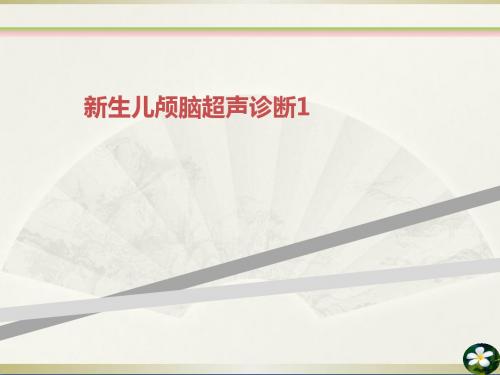
1.李鸿章1872年在上海创办轮船招商局,“前10年盈和,成
为长江上重要商局,招商局和英商太古、怡和三家呈鼎立
之势”。这说明该企业的创办
()
A.打破了外商对中国航运业的垄断
B.阻止了外国对中国的经济侵略
C.标志着中国近代化的起步
D.使李鸿章转变为民族资本家
解析:李鸿章是地主阶级的代表,并未转化为民族资本家; 洋务运动标志着中国近代化的开端,但不是具体以某个企业 的创办为标志;洋务运动中民用企业的创办在一定程度上抵 制了列强的经济侵略,但是并未能阻止其侵略。故B、C、D 三项表述都有错误。 答案:A
观察新生儿尤其是早产儿及窒息的新生儿主要从以 下几方面
1.颅内结构层次是否清晰 2.脑中线是否居中 3.双侧脑室扩张情况 4.双侧脉络从是否对称,回声是否均匀,形态是否规整 5.脑室周围情况 6.大脑皮质沟回显示情况
新生儿正常的颅脑超声表现
脑表面有三层膜,由外向里依次为:硬脑膜、 蛛网膜和软脑膜。
D.航空运输
解析:根据所学1872年李鸿章创办轮船招商局,这是洋务
运动中由军工企业转向兼办民用企业、由官办转向官督商
办的第一个企业。具有打破外轮垄断中国航运业的积极意
义,这在一定程度上保护了中国的权利。据此本题选C项。
答案:C
2. 右图是1909年《民呼日报》上登载的 一幅漫画,其要表达的主题是( ) A.帝国主义掠夺中国铁路权益 B.西方国家学习中国文化 C.西方列强掀起瓜分中国狂潮 D.西方八国组成联军侵略中国
宽
新生儿颅内出血的类型
脑室周围-脑室内出血(PVH--IVH) 脑实质出血(IPH) 大的硬脑膜下出血(SDH)
脑室内出血的分级
I级:单或双侧室管膜下出血。
医院超声检查颅脑检查常规
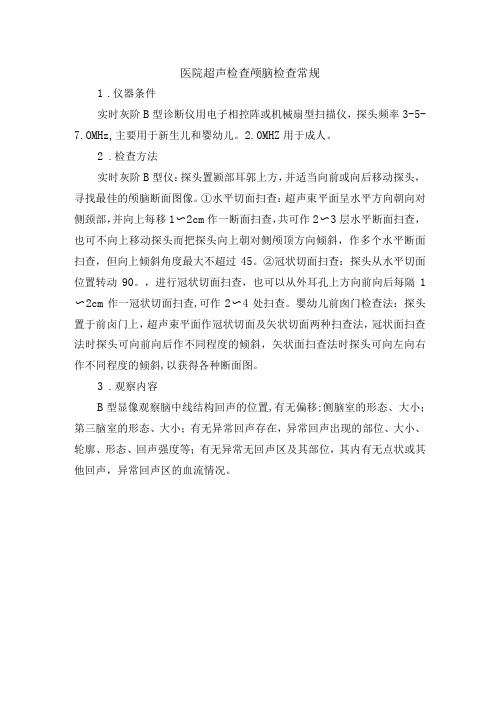
医院超声检查颅脑检查常规
1.仪器条件
实时灰阶B型诊断仪用电子相控阵或机械扇型扫描仪,探头频率3-5-7.OMHz,主要用于新生儿和婴幼儿。
2.0MHZ用于成人。
2.检查方法
实时灰阶B型仪:探头置颍部耳郭上方,并适当向前或向后移动探头,寻找最佳的颅脑断面图像。
①水平切面扫查:超声束平面呈水平方向朝向对侧颈部,并向上每移1〜2cm作一断面扫查,共可作2〜3层水平断面扫查,也可不向上移动探头而把探头向上朝对侧颅顶方向倾斜,作多个水平断面扫查,但向上倾斜角度最大不超过45。
②冠状切面扫查:探头从水平切面位置转动90。
,进行冠状切面扫查,也可以从外耳孔上方向前向后每隔1〜2cm作一冠状切面扫查,可作2〜4处扫查。
婴幼儿前囱门检查法:探头置于前卤门上,超声束平面作冠状切面及矢状切面两种扫查法,冠状面扫查法时探头可向前向后作不同程度的倾斜,矢状面扫查法时探头可向左向右作不同程度的倾斜,以获得各种断面图。
3.观察内容
B型显像观察脑中线结构回声的位置,有无偏移;侧脑室的形态、大小;第三脑室的形态、大小;有无异常回声存在,异常回声出现的部位、大小、轮廓、形态、回声强度等;有无异常无回声区及其部位,其内有无点状或其他回声,异常回声区的血流情况。
颅脑血管超声操作流程

颅脑血管超声操作流程英文回答:Transcranial Cerebral Vasculature Ultrasound Procedure.Pre-Procedure Preparation:Obtain informed consent from the patient.Ensure the patient is in a supine position with their neck slightly extended.Establish a sterile field and apply sterile ultrasound gel to the temporal and occipital regions of the scalp.Device and Equipment Setup:Select an appropriate ultrasound transducer (typically 2-5 MHz) and connect it to the ultrasound machine.Set the imaging parameters to optimize visualization of cerebral blood flow.Position the patient's head in the neutral position and secure it with a headrest or sandbags.Transcranial Doppler Ultrasound (TCD) Procedure:Use the ultrasound probe to locate the temporal window and then angle it towards the middle cerebral artery (MCA).Adjust the probe position and angle to maximize the Doppler signal.Measure and record the peak systolic velocity (PSV), end-diastolic velocity (EDV), and mean flow velocity (MFV) of the MCA.Repeat the process for the intracranial carotid artery (ICA) and vertebral artery (VA).Color Doppler Ultrasound (CDU) Procedure:After obtaining Doppler signals, switch the imaging mode to color Doppler.Use the ultrasound probe to scan the entireintracranial vasculature.Assess the presence, flow direction, and velocity of blood flow in the major cerebral arteries and veins.Identify any abnormalities such as stenosis, occlusion, or aneurysms.Post-Procedure Care:Remove the ultrasound gel from the patient's scalp.Monitor the patient for any adverse reactions or complications.Provide the patient with the results of theexamination and any necessary follow-up instructions.中文回答:颅脑血管超声操作流程。
优选血管超声操作及测量手法演示ppt

血流方向
y 声束入 射方向
x
5、建立较佳的彩色速度刻度(color velocity scale)或脉冲重复频率 (pulse repetition frequency)
不产生色彩倒错现象的最低彩色刻度或脉 冲重复频率,将提高血管内彩色血流信号 的敏感性。
紊乱血流的色彩表现:多数正常动脉和
提高血管内彩色血流信号的敏感性
1、选择合适的探头 2、改变扫查的方法: 探头适当加压以缩小探头与探测目标之间的距离可
以提高分辨率,也有助于改善血管内的彩色血流 信号显示。 尽可能利用声窗,避开声衰较强的组织 设法减小声束与血流方向的夹角,从而改善彩色血 流信号的显示。 彩色信号强度与多普勒频移幅度相关 多普勒频移与声源和接收器的相对速度相关
大静脉的血流均为层流(中心明亮,靠近 管壁黯淡)。当血流通过狭窄处(如动脉 狭窄)或扩张处(动脉瘤)时,其血流方 向和速度可发生改变,出现色彩倒错或者 五彩镶嵌等彩色血流。
偏差θ度数 COSθ数值 向上分量速度 推算血流速度 偏差倍率
1度
0.999
100 100.1001001 1.001001
60度
0.5
100
200
1
偏差+10度(70
0.34
100 294.1176 1.470588
偏差+15度(75
0.25
1100 156.25 偏低22%
偏差+15度(45
0.71
100 140.85 偏低29.5%
80度(假设真实角度)
0.17
100 588.2353
1
偏差5度85度
0.09
100 1111.111 1.888889
脑血管超声
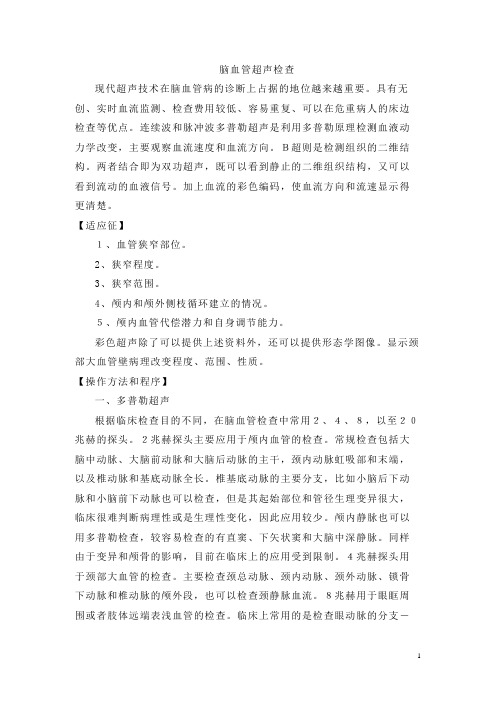
脑血管超声检查现代超声技术在脑血管病的诊断上占据的地位越来越重要。
具有无创、实时血流监测、检查费用较低、容易重复、可以在危重病人的床边检查等优点。
连续波和脉冲波多普勒超声是利用多普勒原理检测血液动力学改变,主要观察血流速度和血流方向。
B超则是检测组织的二维结构。
两者结合即为双功超声,既可以看到静止的二维组织结构,又可以看到流动的血液信号。
加上血流的彩色编码,使血流方向和流速显示得更清楚。
【适应征】1、血管狭窄部位。
2、狭窄程度。
3、狭窄范围。
4、颅内和颅外侧枝循环建立的情况。
5、颅内血管代偿潜力和自身调节能力。
彩色超声除了可以提供上述资料外,还可以提供形态学图像。
显示颈部大血管壁病理改变程度、范围、性质。
【操作方法和程序】一、多普勒超声根据临床检查目的不同,在脑血管检查中常用2、4、8,以至20兆赫的探头。
2兆赫探头主要应用于颅内血管的检查。
常规检查包括大脑中动脉、大脑前动脉和大脑后动脉的主干,颈内动脉虹吸部和末端,以及椎动脉和基底动脉全长。
椎基底动脉的主要分支,比如小脑后下动脉和小脑前下动脉也可以检查,但是其起始部位和管径生理变异很大,临床很难判断病理性或是生理性变化,因此应用较少。
颅内静脉也可以用多普勒检查,较容易检查的有直窦、下矢状窦和大脑中深静脉。
同样由于变异和颅骨的影响,目前在临床上的应用受到限制。
4兆赫探头用于颈部大血管的检查。
主要检查颈总动脉、颈内动脉、颈外动脉、锁骨下动脉和椎动脉的颅外段,也可以检查颈静脉血流。
8兆赫用于眼眶周围或者肢体远端表浅血管的检查。
临床上常用的是检查眼动脉的分支-滑车动脉和手部动脉。
20兆赫探头主要应用于开颅时直接在血管表面测量血流速度。
(一)颈部动脉多普勒超声检查操作方法1探头:笔式连续波或者脉冲波探头,4兆或者5兆频率。
2患者平卧,在检查部位或者探头放置足量超声耦合剂将探头轻放在皮肤上,保持探头检查面与皮肤紧密相接触,但是应该避免用力加压,以免压迫血管造成检查误差。
颅内动脉超声检查方法
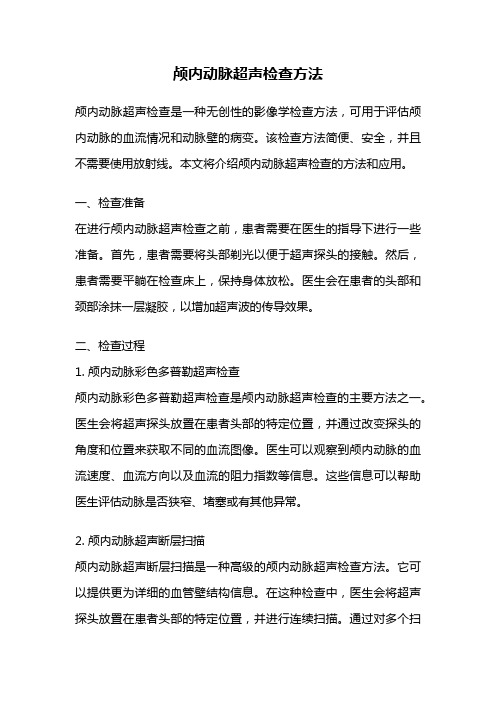
颅内动脉超声检查方法颅内动脉超声检查是一种无创性的影像学检查方法,可用于评估颅内动脉的血流情况和动脉壁的病变。
该检查方法简便、安全,并且不需要使用放射线。
本文将介绍颅内动脉超声检查的方法和应用。
一、检查准备在进行颅内动脉超声检查之前,患者需要在医生的指导下进行一些准备。
首先,患者需要将头部剃光以便于超声探头的接触。
然后,患者需要平躺在检查床上,保持身体放松。
医生会在患者的头部和颈部涂抹一层凝胶,以增加超声波的传导效果。
二、检查过程1. 颅内动脉彩色多普勒超声检查颅内动脉彩色多普勒超声检查是颅内动脉超声检查的主要方法之一。
医生会将超声探头放置在患者头部的特定位置,并通过改变探头的角度和位置来获取不同的血流图像。
医生可以观察到颅内动脉的血流速度、血流方向以及血流的阻力指数等信息。
这些信息可以帮助医生评估动脉是否狭窄、堵塞或有其他异常。
2. 颅内动脉超声断层扫描颅内动脉超声断层扫描是一种高级的颅内动脉超声检查方法。
它可以提供更为详细的血管壁结构信息。
在这种检查中,医生会将超声探头放置在患者头部的特定位置,并进行连续扫描。
通过对多个扫描层面的图像进行整合,医生可以获得颅内动脉的断面图像。
这些图像可以帮助医生判断动脉壁是否存在斑块、狭窄或其他异常。
三、检查结果分析根据颅内动脉超声检查的结果,医生可以进行相应的分析和判断。
如果血流速度和方向正常,动脉壁结构无异常,那么可以判定颅内动脉功能正常。
如果发现血流速度减慢、方向异常或者动脉壁存在异常,那么可能存在动脉狭窄、堵塞或其他病变。
医生会根据具体情况制定相应的治疗方案或进一步的检查。
四、应用领域颅内动脉超声检查在临床上有广泛的应用。
它可以用于评估脑血管疾病的风险,如脑梗死、脑出血等。
此外,颅内动脉超声检查也可以用于评估脑血管手术的效果和预后。
对于有高血压、高血脂、糖尿病等脑血管疾病危险因素的人群,定期进行颅内动脉超声检查可以帮助早期发现病变,采取相应的治疗措施。
- 1、下载文档前请自行甄别文档内容的完整性,平台不提供额外的编辑、内容补充、找答案等附加服务。
- 2、"仅部分预览"的文档,不可在线预览部分如存在完整性等问题,可反馈申请退款(可完整预览的文档不适用该条件!)。
- 3、如文档侵犯您的权益,请联系客服反馈,我们会尽快为您处理(人工客服工作时间:9:00-18:30)。
颅脑血管超声操作流程
英文回答:
The procedure for performing a transcranial Doppler (TCD) ultrasound examination involves several steps. First, the patient is positioned comfortably in a supine or semi-reclining position. The examiner then applies a water-based gel to the patient's temples, behind the ear, and on the midline of the forehead. This gel helps to improve the transmission of ultrasound waves and ensures good contact between the transducer and the skin.
Next, the examiner selects the appropriate transducer for the examination. There are different types of transducers available, such as a phased array or a sector transducer. The choice of transducer depends on the
specific clinical question and the area of interest.
Once the transducer is selected, the examiner places it on the gel-covered skin and adjusts the position to obtain
the best possible image. The transducer is usually placed over the temporal window, which provides access to the middle cerebral artery (MCA) and other intracranial vessels. The examiner may need to tilt or rotate the transducer to visualize different vessels or angles.
During the examination, the examiner uses the
ultrasound machine to adjust the settings, such as the
depth and gain, to optimize the image quality. The examiner then begins to perform the TCD examination by scanning the area of interest. The transducer emits ultrasound waves, which penetrate the skull and bounce off the moving blood cells in the vessels. The returning waves are detected by the transducer and converted into a Doppler signal, which
is displayed on the ultrasound machine.
The examiner carefully evaluates the Doppler signals to assess the blood flow characteristics in the intracranial vessels. The examiner looks for abnormalities, such as stenosis, occlusion, or turbulence in the blood flow. The examiner may also measure the velocity of the blood flow using spectral Doppler analysis.
In addition to the TCD examination, the examiner may perform other techniques, such as color Doppler or power Doppler imaging, to further evaluate the blood flow patterns. These techniques provide additional information about the direction and velocity of the blood flow.
Once the examination is complete, the examiner removes the gel from the patient's skin and ensures that the patient is comfortable. The examiner then analyzes the obtained images and Doppler signals to make a diagnosis or provide a report to the referring physician.
中文回答:
颅脑血管超声检查的操作流程包括几个步骤。
首先,将患者舒适地放置在仰卧位或半卧位上。
检查者然后在患者的太阳穴、耳后和额头中线处涂抹一层水基凝胶。
这种凝胶有助于改善超声波的传输,并确保探头与皮肤之间有良好的接触。
接下来,检查者选择适合的探头进行检查。
有不同类型的探头可供选择,例如相控阵探头或扇形探头。
探头的选择取决于具体的
临床问题和感兴趣的区域。
一旦选择了探头,检查者将其放置在涂有凝胶的皮肤上,并调整位置以获得最佳图像。
通常将探头放置在颞窗上,这样可以进入大脑中动脉(MCA)和其他颅内血管。
检查者可能需要倾斜或旋转探头以可视化不同的血管或角度。
在检查过程中,检查者使用超声机调整设置,如深度和增益,以优化图像质量。
然后,检查者开始进行颅脑血管超声检查,扫描感兴趣的区域。
探头发射超声波,穿透颅骨并反射回血管中移动的血细胞。
探头检测到返回的波并将其转换为多普勒信号,该信号显示在超声机上。
检查者仔细评估多普勒信号,以评估颅内血管中的血流特征。
检查者寻找异常,例如血流狭窄、闭塞或湍流。
检查者还可以使用频谱多普勒分析测量血流速度。
除了颅脑血管超声检查,检查者还可以进行其他技术,例如彩色多普勒或动力多普勒成像,以进一步评估血流模式。
这些技术提供了有关血流方向和速度的额外信息。
检查完成后,检查者清除患者皮肤上的凝胶,并确保患者感到
舒适。
然后,检查者分析获得的图像和多普勒信号,以做出诊断或向转诊医生提供报告。
